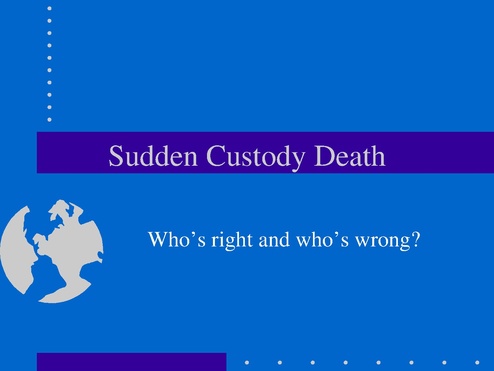Taser Sudden Custody Death Ppt
Download original document:

Document text

Document text
This text is machine-read, and may contain errors. Check the original document to verify accuracy.
Sudden Custody Death Who’s right and who’s wrong? Excited Delirium & SCDS • The victims of SCDS usually have levels of identifiable foreign agents in their system that trigger abnormal behavior, actions, reactions or personal conduct. They die in ambulances, emergency rooms, trauma centers and under the immediate care of trained and highly skilled medical personnel. COCAINE Psychosis • Original studies of these fatalities in custody began back in the 80’s in Miami with Metro-Dade police. The studies began as an attempt by medical examiners to understand why people were dying in police custody. There was no apparent reason for the death. So, why did they die? • Studies broadened as examiners found these deaths were not just occurring with police arrests • Common denominator in these deaths… the level of cocaine found post mortem in toxicology results Research Findings • 1. Overdose - 6 mg/l (milligrams per litre) • 2. Cocaine psychosis victims as low as .6 mg/l • Physiological symptoms..seizures, high temps, dilated pupils • High % had been “hog-tied” HYPERTHERMIA • Psychostimulant drugs such as amphetamines, amphetamine derivatives, and cocaine can produce a number of potentially lethal effects • Psychostimulant overdoses can cause cardiovascular compromise, seizures, and hyperthermia. • Hyperthermia is a common result due to severe doses or overdoses • Hyperthermia also occurs in lower doses of psychostimulants and may cause rhabdomyolysis. • Activation of particular dopamine receptors in the central nervous system may cause psychostimulant induced hyperthermia. Excited Delirium • Continued fatality studies reveled behavioral similarities between cocaine psychosis victims and those under the influence of other drugs. • Sometimes even the lack of having taken certain prescription drugs could cause a similar response in abnormal behavior (such as lithium in the case of certain manic depressants) • New term - excited delirium - came about Symptoms and behavioral patterns • • • • • • • bizarre and aggressive behavior dilated pupils fear high temps (106-108) hiding behind things irrational, incoherent speech jumping into water symptoms • • • • • • • panic paranoia profuse sweating public disrobing self-inflicted injuries shivering shouting symptoms • • • • • • seizures unexpected physical strength violent behavior (general) violence towards others violence towards objects (glass) watch for more than one symptom CASE HISTORIES • 1. Minneapolis tree climber • 2. Minneapolis man on Lyndale • 3. Minneapolis north side incident Positional Asphyxia • The position of the body interferes with the person’s ability to breath. • Interference with proper breathing produces an oxygen deficiency (hypoxia) in the blood which disturbs the body’s chemistry and can create a condition for fatal rhythm disturbance in the heart. DR. Reay’s study • Pub. 1988 - Am. J. Forensic Med. Pathology • concluded that after exercise (or violent struggles) blood oxygen levels decrease. • “Hog-tie Restraints” prevent these levels from rising again because it impairs the mechanical process of inhaling and exhaling. • Lactic Acidosis occurs and subject cannot exhale enough of the carbon dioxide that builds up. DR. Thomas Neuman’s study • 1988 case - Price v. County of San Diego • Tests conducted at UCSD Medical Center • finding - blood oxygen levels do not decrease after exercise (struggle). The blood maintains enough oxygen. • hog-tie restraint impairs normal breathing to an extent but does not affect blood oxygen or carbon dioxide levels. • Methodological and logical flaws of Reay’s study were explained • Reay retracted his findings U.S. Court of Appeals 10th Circuit Cruz v. City of Laramie, WY • Holding: Hog tie on suspects with diminished capacity considered excessive force in Sec. 1983 action. • Court’s understanding is that a hog tie is binding legs to hands with 12 inches or less of separation. • Did not reach the question as to whether all hog tie restraints were a constitutional violation per se, but did hold that applying this technique when a subjects diminished capacity is apparent is unreasonable. Drugs, Death, and Blame • Always keep in mind that people that exhibit symptoms and behavioral patterns suggesting cocaine psychosis or excited delirium are experiencing a medical emergency • Manic depressants taking Lithium will sometimes discontinue taking their meds. These subjects often appear to be in a state of Excited Delirium and may well be. • Excited Delirium is regarded as a “medical emergency with a psychological presentation” • BEWARE of SUDDEN TRANQUILITY • Try to minimize the appearance of “mishandling” suspect.

